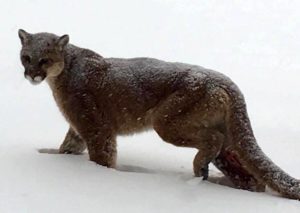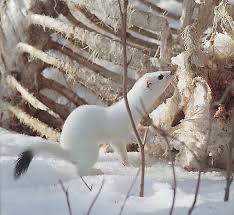
The Wilhelms, who live at the end of North Inlet Road in Grand Lake, had a visitor as wondrous as Santa this Christmas morning. A mountain lion added to their celebration by strolling across their yard, just fifteen feet from their picture window. Joy Wilhelm was quick thinking and snapped the accompanying photo, and then a neighbor friend posted it on Facebook for the rest of us to enjoy. From everyone’s reaction, it’s clear that not many have had the opportunity to see a mountain lion this close . . . without also seeing their life flash before their eyes.
I’m calling this beautiful creature a mountain lion, but this species actually goes by more names than any other animal—85 to be exact. The most common are puma, cougar, panther and catamount; the more exotic include fire cat, ghost cat, Indian devil, mountain screamer and sneak cat. Given some of their more sinister names, humans have obviously feared this animal throughout history. So, my question is: does the mountain demon (yet another of their more colorful names) deserve this reputation?
Today, mountain lions thrive in fourteen Western states, including ours. There’s also a very small and endangered population, less than a hundred, in Florida. Given their solitary and elusive manner, it’s impossible to get an accurate count, but it’s estimated that somewhere between 3,000-7,000 mountain lions call Colorado home. (Yikes! That’s waaaay more than I personally expected.)
If you’ve ever hiked, I’m sure it’s crossed your mind that a mountain lion kills by jumping down from a tree, landing on the unsuspecting person’s back, and then clamping onto the base of the skull and breaking the neck with their seriously huge chompers. I’m not advocating blowing off this potential danger, but according to the Colorado Division of Wildlife, there have been less than a dozen fatalities as a result of mountain lion attacks in North America in more than one hundred years. Two took place in Colorado, with unfortunately one of those occurring in the Rocky Mountain National Park back in July 1997. There are an average of five non-fatal attacks across the U.S. and Canada each year. The last non-fatal attack in Colorado was in June 2016, just northwest of Aspen. Bottom line: mountain lions are definitely responsible for bad things, but probably not as often as any of us imagine.
Should you ever encounter a mountain lion without a protective pane of glass separating you from it, here’s what to do. First, do NOT run; it triggers their chase instinct. Maintain eye contact and never turn your back. Yell, wave your arms and try to look big. If that doesn’t work, fight back and do not play dead. Most importantly, protect your neck and try to remain standing.
The Wilhelms may not get another chance to view their king cat because a male’s territory is 100 miles and a female will regularly roam between 30-60 square miles. Their maybe-once-in-a-lifetime encounter was, luckily, filled with awe and wonder, just like Christmas morning should be.
Originally published in The Boardwalk newspaper, Grand Lake, Colorado.

